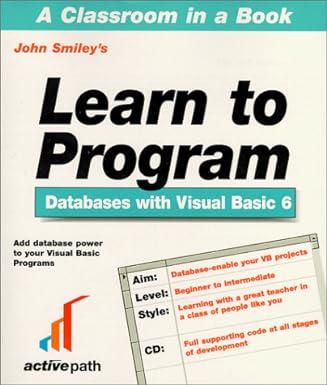Question
PYTHON QUESTION Now, let's try to incorporate menus into the full Restaurants program. Start by downloading a clean copy of the first version of the
PYTHON QUESTION
Now, let's try to incorporate menus into the full Restaurants program. Start by downloading a clean copy of the first version of the restaurants program(below); if you're confident in the version you modified in part (d), you may start with that version instead. For this part, create a separate file called restaurantsf.py. You'll turn that file in along with your lab5.py file and the restaurantsd.py file you created earlier.
Our advice about taking things slowly and methodically applies here as never before. If you find yourself running out of time at the end of the week, it may well be because you weren't methodical enough about making changes to this code.
The original program has a section for Restaurants and a section for Collections. You'll want to add a section for Dishes and a section for Menus. In the Dish section, include the functions dish_str (which you already wrote) and dish_get_info, which works along the same lines as restaurant_get_info.
Now, in the Menus section, write a menu_enter function that repeatedly asks whether the user wants to add a Dish. If the user enters yes, the function prompts the user to create a Dish and adds it on to the growing list of dishes; when the user enters no, the function returns the compiled list of Dishes. Now, where do we have to call menu_enter and take the Menu it returns, including it into the whole data structure in the appropriate place? In the Menus section, you'll also need something to create a display string for the menu of dishes; you'll also need to find where in the program to call the function that generates the Menu display string.
Next, incorporate your price-changing code into the program so that ultimately, the main menu gives the same option as above:
c: Change prices for the dishes served
When the user types c, the program should ask the user for an amount representing a percentage change in price, as before, and it should apply that price change to the prices for all the Dishes in all the Restaurants in the collection.
Finally, if you have time, also incorporate a top-level command that selects restaurants with prices at or below a specified value, reusing the code you defined above where appropriate.
(the first version)
# Implement Restaurant as a namedtuple, collection as a list
##### MAIN PROGRAM (CONTROLLER) def restaurants(): # nothing -> interaction """ Main program """ print("Welcome to the restaurants program!") our_rests = collection_new() our_rests = handle_commands(our_rests) print(" Thank you. Good-bye.") MENU = """ Restaurant Collection Program --- Choose one a: Add a new restaurant to the collection r: Remove a restaurant from the collection s: Search the collection for selected restaurants p: Print all the restaurants q: Quit """ def handle_commands(diners: list) -> list: """ Display menu, accept and process commands. """ done = False while not done: response = input(MENU) if response=="q": done = True return diners elif response=='a': r = restaurant_get_info() diners = collection_add(diners, r) elif response=='r': n = input("Please enter the name of the restaurant to remove: ") diners = collection_remove_by_name(diners, n) elif response=='p': print(collection_str(diners)) elif response=='s': n = input("Please enter the name of the restaurant to search for: ") for r in collection_search_by_name(diners, n): print(restaurant_str(r)) else: invalid_command(response) def invalid_command(response): # string -> interaction """ Print message for invalid menu command. """ print("Sorry; '" + response + "' isn't a valid command. Please try again.") ##### Restaurant from collections import namedtuple Restaurant = namedtuple('Restaurant', 'name cuisine phone dish price') # Constructor: r1 = Restaurant('Taillevent', 'French', '01-11-22-33-44', 'Escargots', 23.50) def restaurant_str(self: Restaurant) -> str: return ( "Name: " + self.name + " " + "Cuisine: " + self.cuisine + " " + "Phone: " + self.phone + " " + "Dish: " + self.dish + " " + "Price: ${:2.2f}".format(self.price) + " ") def restaurant_get_info() -> Restaurant: """ Prompt user for fields of Restaurant; create and return. """ return Restaurant( input("Please enter the restaurant's name: "), input("Please enter the kind of food served: "), input("Please enter the phone number: "), input("Please enter the name of the best dish: "), float(input("Please enter the price of that dish: "))) #### COLLECTION # A collection is a list of restaurants def collection_new() -> list: ''' Return a new, empty collection ''' return [ ] def collection_str(diner_collection: list) -> str: ''' Return a string representing the collection ''' s = "" for r in diner_collection: s = s + restaurant_str(r) return s def collection_search_by_name(diner_list: list, diner_name: str) -> list: """ Return list of Restaurants in input list whose name matches input string. """ result = [ ] for r in diner_list: if r.name == diner_name: result.append(r) return result def collection_add(diner_list: list, diner: Restaurant) -> list: """ Return list of Restaurants with input Restaurant added at end. """ diner_list.append(diner) return diner_list def collection_remove_by_name(diners: list, diner_name: str) -> list: """ Given name, remove all Restaurants with that name from collection. """ result = [ ] for r in diners: if r.name != diner_name: result.append(r) return result restaurants()
Step by Step Solution
There are 3 Steps involved in it
Step: 1

Get Instant Access to Expert-Tailored Solutions
See step-by-step solutions with expert insights and AI powered tools for academic success
Step: 2

Step: 3

Ace Your Homework with AI
Get the answers you need in no time with our AI-driven, step-by-step assistance
Get Started


